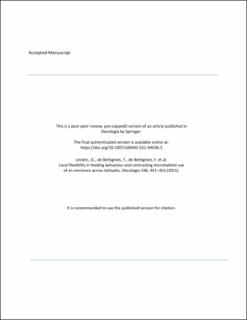| dc.description.abstract | As the environment is getting warmer and species are redistributed, consumers can be forced to adjust their interactions with available prey, and this could have cascading effects within food webs. To better understand the capacity for foraging flexibility, our study aimed to determine the diet variability of an ectotherm omnivore inhabiting kelp forests, the sea urchin Echinus esculentus, along its entire latitudinal distribution in the northeast Atlantic. Using a combination of gut content and stable isotope analyses, we determined the diet and trophic position of sea urchins at sites in Portugal (42° N), France (49° N), southern Norway (63° N), and northern Norway (70° N), and related these results to the local abundance and distribution of putative food items. With mean estimated trophic levels ranging from 2.4 to 4.6, omnivory and diet varied substantially within and between sites but not across latitudes. Diet composition generally reflected prey availability within epiphyte or understorey assemblages, with local affinities demonstrating that the sea urchin adjusts its foraging to match the small-scale distribution of food items. A net “preference” for epiphytic food sources was found in northern Norway, where understorey food was limited compared to other regions. We conclude that diet change may occur in response to food source redistribution at multiple spatial scales (microhabitats, sites, regions). Across these scales, the way that key consumers alter their foraging in response to food availability can have important implication for food web dynamics and ecosystem functions along current and future environmental gradients. | |
